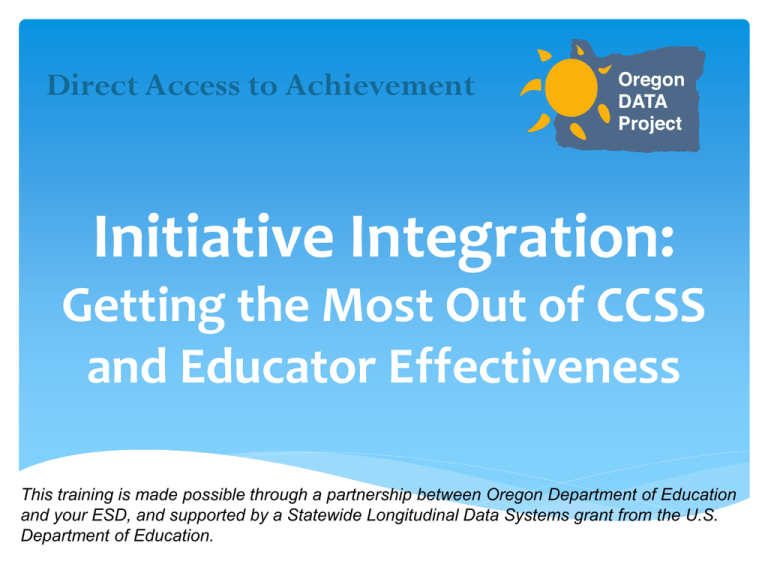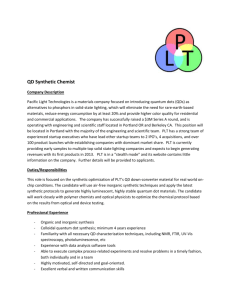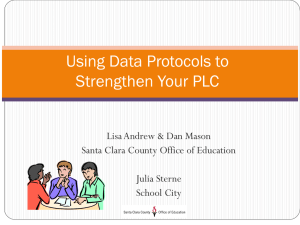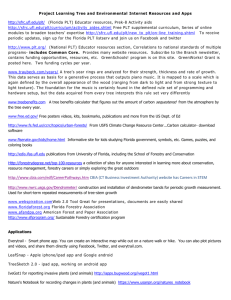Powerpoint Presentation by Hood River, Centennial, and David
advertisement

Direct Access to Achievement Initiative Integration: Getting the Most Out of CCSS and Educator Effectiveness This training is made possible through a partnership between Oregon Department of Education and your ESD, and supported by a Statewide Longitudinal Data Systems grant from the U.S. Department of Education. When our efforts aren’t integrated and aligned…how likely is our actual progress? The likelihood of progress increases when we integrate essential elements of new initiatives using a systems approach to align our efforts. Be selective about who is trained Be clear about your purpose for the training Oregon’s DATA CCSS Educator Effectiveness RTI Strategically Supporting Student Learning Administration, SustainBuild Capacity, Monitor, Support, Data Start with willingness Have a rollout plan Determine how to get coaching support and feedback Staff Coaching OUTCOMES (% of Participants who Demonstrate Knowledge, Demonstrate new Skills in a Training Setting, and Use new Skills in the Classroom) Knowledge Skill Demonstration Use in the Classroom Theory and Discussion 10% 5% 0% ..+Demonstration in Training 30% …+ Practice & Feedback in Training 60% 60% 5% …+ Coaching in Classroom 95% 95% 95% TRAINING COMPONENTS 20% 0% Joyce and Showers, 2002 www.OregonDataProject.org Visit the Direct Access to Achievement (DATA) Project website to access materials and resources. www.oregondataproject.org 2013-2014 Webinar schedule Oct. 30, 3:30-4:30 p.m. Initiative Integration: Getting the Most Out of CCSS and Educator Effectiveness Feb. 26, 3:30-4:30 p.m. Making it Stick: Going from Training to Implementation Practice April 23, 3:30-4:30 p.m. What Difference Is this Making? Evaluating Program Effectiveness and Fidelity of Implementation For connection information, visit the Oregon DATA Project page, Hood River County School District Jane Osborne Building a Culture of Data… It’s all about the evidence! www.hoodriver.k12.or.us Jane Osborne jane.osborne@hoodriver.k12.or.us Evaluating Student Progress September April Creating common assessments… It’s all about the evidence! How it all began…. Data from 2008 Building Background…. Learning about Professional Learning Communities Visits to White River School District Administration team attends regional Dufour workshop Teacher/Admin teams attended various Solution Tree/Dufour conferences Janel Keating and Bob Eaker visit HR At a Glance…. Year Elementary Focus Middle School Focus High School Focus 2009-2010 Math Implementation Teams By subject Vertically aligned Department Teams 2010-2011 Early Release 2 hours Math Implementation Teams By subject vertically aligned with both middle schools Department Teams 2011-2012 Writing Teams horizontally aligned by course Focus on Diploma Requirements 2012-2013 Accountable teams by common course taught Learning Cycle—pretest, teach, posttest, intervene Focused on data and results Early Release 2 hours Early Release 2 hours Late Starts Weekly 1 hour Then we read… Every School, Every Team, Every Classroom, by Bob Eaker and Janel Keating PLC leadership team visited -- + White River + La Grande We realized…. Needed a system to gather evidence Analyze data and plan for next steps and set goals Team Leaders Team Leader job description Very small stipend Training quarterly Supported by principals and instructional coaches The Turning Point…. High School diploma requirements increase Essential Common Skills requirements Core Standards Need to do things differently—transitioning to more rigorous instruction and assessment Oregon 17 DATA Project Certification Training teachers and 10 administrators from each building trained/ 100 day Plan for leaders Oregon DATA Project Training Accountability Administrators engaged in and modeled the same practices expected by teachers. During monthly “Academic Ad Council” meetings, principals participated in teams using all the same forms and structures that teachers used on Monday mornings Admin Team at work Admin Doing the work Created a System… Forms Administrators train and model—go through everything the teams do Accountability http://www.hoodriver.k12.or.us/Page/198 Agenda and Minutes Form PLC TEAM AGENDA AND MINUTES FORM Meeting Date: ____________School: ______________ Team:________________ Team Members Present: __________________ PLC work to ensure learning: 1) 2) 3) 4) What do we expect students to learn? How will we know if they learn it? How do we respond when students don’t learn? How do we respond when students do learn? Agenda Items: Facilitator: ______________________________________ ______________________________________ Team Members Absent:________________ _____ Notetaker: Timekeeper: 1. Review Norms 2. TO DO: (who/by when) 3. TO DO: (who/by when) 4. TO DO: (who/by when) (Minutes for each agenda item should include highlights of the discussions, decisions, follow-up tasks, who is responsible for what and by when.) Successes from Today: Focus for Next Meeting: What to Bring: (data, resources, etc.): Questions/Concerns: Needs from Building Administrators: Copies to: Team Leader and Building Administrators Monthly Planning Tool (The Black Box) Team Analysis of Common Assessment form 7/9/13 Team Analysis of a Common Assessment TEAM ANALYSIS OF COMMON ASSESSMENT School Grade Level Subject Area Name of Assessment Collect data Analyze data Establish Goals/Instructional Strategies Determine Results Indicators Evaluate effectiveness 5 min Power Standards or Learning Targets Measured 5 min In what areas did our students do well on this assessment? 5 min What instructional strategies helped our students do well? (skip this question if you are using a pre-assessment) 5 min What skill deficiencies do we see? 5 min What patterns do we see in the mistakes and what do they tell us? 5 min Which students did not master essential standards and will need additional time and support? (Analyzing Student Work (ASW) form) 5 min Which students did not master essential standards and will need additional time and support? (Analyzing Student Work (ASW) form) 20 min What interventions, and/or instructional strategies will be provided to address unlearned skills, and how will we check for success? (If teachers ----------, then students will-----------.) 5 min Do we need to tweak or improve this assessment? 10 min Which students mastered standards and what is our plan for extension and enrichment? Class 1 Class 2 Class 3 Class 4 Class 5 Class 6 Class 7 Total Stu Intensive Strategic Approaching Standard Meeting Standard 100% Teachers fill in numbers and… Automatically fills in graph Middle School Team Analysis of Common Assessment (TACA)presentations 5th grade team …with a District Observer Observation Form Observation Form Get Started Create a System Monitor and Be Accountable Celebrate Results It’s all about the evidence! Results Centennial School District Cheryl Williamson CCSS and Educator Effectiveness It’s the Data Centennial School District 2010 - 2011 • Developed pacing guide/”starter” curriculum maps based on Common Core • Invited principals to attend a 2-hour introduction to the data teams process • Gave slots to buildings and had them sign an MOU agreeing to participate – Buildings could “buy” more slots • All buildings signed on – had 96 names 2011 - 2012 • Trainer met with principals to get sense of staff understanding of PLCs/use of data • Three sessions (2 elementary, 1 secondary) – Principals participated along with their staff • Three half-day trainings – First day – Overview of process – Second/third days – Guided Data Teams process using their data • Developed cycle notes 2012 - 2013 • Changed PLC schedule to allow for coach support • Trained 50 additional staff in 3 half-day sessions • Set expectation of 3 cycles for the year focused on CCSS • Trained building coaches to support the process • Re-trained staff on steps 2, 4 & 5 • Worked with principals on providing feedback on the cycle notes • Introduced notion of running agendas • Revised cycle notes (end of year) 2013 - 2014 • Continue with PLC building schedule • Added Educator Effectiveness – Data has taken on a greater sense of urgency • Sent 52 elementary teachers and principals to ATI training (Stiggins) • Pair data teams/assessment literacy to train staff how to write good classroom-based assessments – Follow-up with guided data teams training focused on using the assessment data to inform instruction Lessons Learned What Worked Principal is key Infrastructure was in place (pacing guides/maps) Persistence/ willingness to retrain when necessary Structure/scaffold the conversation more at first Ongoing coach support Trust the process What would we do differently Principals had varying degrees of comfort with leading this process Feedback on cycle notes made the conversation all about the form Teams struggled more when only part of the team was trained Be clear about the connections between initiatives up front Moving Forward • Develop a clear vision for integration of CCSS and Educator Effectiveness – Can’t have “one more thing” • Keep data front and center – Use student data to inform instruction – Use adult and student data to measure effectiveness • Electronic version of cycle notes/feedback system for staff • Differentiate support for staff David Douglas School District Amy McQueen Brooke O’Neill PROFESSIONAL LEARNING TEAMS David Douglas School District Portland, OR PRESENTED BY Brooke O’Neill: brooke_oneill@ddouglas.k12.or.us Amy McQueen: amy_mcqueen@ddouglas.k12.or.us STRATEGICALLY INCREASING STUDENT ACHIEVEMENT STUDENTS STANDARDS UNWRAPPING THE STANDARDS PLT QUESTION #1: What do all students need to know and be able to do? (Standards) COMMON ASSESSMENTS ANALYZING STUDENT WORK FOR DIFFERENTIATION SELECT COMMON INSTRUCTIONAL STRATEGIES & DETERMINE RESULTS INDICATORS SUMMATIVE EVALUATION PROFICIENCY FOR ALL STUDENTS PLT QUESTION #2: How do we teach so that all students will learn? (Instruction) PLT QUESTION #3: How will we know if they have learned it? (Assessment) PLT QUESTION #4: What will we do if they don’t know or if they come to us already knowing? (Intervention & Enrichment) OUR ROAD: GET STARTED, GET BETTER 2010-11: Administrative Training Created and distributed a PLT Handbook to establish Vision and Process. School Board approved weekly 1-hour late start for students to allow PLTs to meet within contract day. Established PLTs across district, all teachers/specialists assigned to either grade level, content, or specialty PLT. Created Google Doc as a Data Record for each step of PLT cycle. Targeted Professional Development at both Elementary and Secondary Level (Science) 2011-12: All staff PLT training prior to start of school year to reestablish a common message and reenergize work. All Curriculum Team Members trained through Oregon DATA Project, Curriculum Team 100 -day Plan developed All District Administrators trained on DATA Team Process—Resources utilized: Guest Speaker: Mickey Garrison, Book Study: Leaders Make it Happen: An Administrator’s Guide to Data Teams (McNulty & Besser) All District Administrators lead a DATA Team Meeting using current school data. Targeted Professional Development at Secondary Level (ELA) 2012-13: PLT designated as one of six DDSD Initiatives PLT Administrative Leadership Team to oversee Initiative Work with the goal of Scaling Up. (EFFECTIVE PRACTICE X EFFECTIVE IMPLEMENTATION = IMPROVED OUTCOMES) DDSD INITIATIVE WORK DRIVING SUSTAINABLE CHANGE PBIS Evaluation PLTs Proficiency RTI Student Achievement Language PROFESSIONAL LEARNING TEAMS • • • What: Professional Learning Teams (PLTs) are structured collaboration with learning as the central goal. Inherent to a PLT is a persistent disquiet with the status quo and a constant search for a better way to achieve goals. Why: o PLTs/Data Teams are the strongest form of professional development and are structured to get results in teaching, learning, and leadership. o PLTs help us to identify specific teaching and leadership actions that have been taken to cause gains in student achievement, helps us to replicate success and helps us eliminate actions that do not produce intended outcomes. o Schools and districts, acting in alignment as a system, make improvement through data-driven inquiry and continuous learning. o PLTs help us inquire, learn more deeply, and provide opportunities for developing leadership, ownership, and accountability across the district CURRENT IMPLEMENTATION LEVEL: EARLY CHILDHOOD – INITIAL K-12 - CONTINUOUS IMPROVEMENT AND REGENERATION Commitment to Continuous Improvemen t Use and Analyze Data Develop Focused Goals and Strategies Focus on Learning PLTs/D ata Teams Results Oriented Action Oriented: Learning by Doing Collective Inquiry into Best Practice & Current Reality LINK TO MODEL CORE TEACHING STANDARDS ● Domain I: Planning and Preparation ○ All Standards ● Domain II: Classroom Environment ○ Standard 2b: Establishing a Culture of Learning ● Domain III: Instruction ○ All Standards ● Domain IV: Professional Responsibilities ○ Standard 4a: Reflecting on Teaching ○ Standard 4d: Participating in a Professional Community ○ Standard 4e: Growing and Developing Professionally ○ Standard 4f: Showing Professionalism ● Domain V: Student Learning and Growth ○ All Standards COMPARING SLG AND PLT PROCESS PLT SLG 1. 2. 3. 4. 5. Collect and chart baseline data to determine needs. Create specific learning goals based on pre-assessments. Create and implement teaching and learning strategies Monitor student progress through ongoing formative assessment process Determine whether students achieved the goal 6. Monitor and Evaluate results 5. Determine results indicators 4. Select common instructional strategies 1. Collect and Chart Data 2. Analyze to prioritize needs 3. Set, review, and revise incremental SMART goals ACTIONS FOR 2013-2014 SCHOOL YEAR ● Train new staff on PLT process (Over 100 Early Childhood Providers) ● Train Elementary Student Achievement Specialists on coaching Data Teams ● Revise the PLT reporting document ○ Elementary aligned with Forward and new teacher evaluation ○ Middle and High School aligned with Common Core ○ Early Childhood aligned with Creative Curriculum and new teacher evaluation ● Communicate the connection of PLT Work to Student Learning and Growth Goals in the Evaluation System. GOALS FOR FUTURE PLT WORK Goal: Create a data literate culture in which teachers are able to effectively analyze common assessments to prioritize needs, align and implement research-based instructional practices to meet needs, and monitor the results. • Conduct training and coaching to ensure that a solid K-12 PLT/Data Team structure exists district-wide. • Provide time for the Administrative PLT Initiative Team to meet to review academic and behavioral data. Allocate resources and support based on data from these meetings. • Train all K-12 staff on how to effectively create and implement Common Formative Assessments. • Train all K-12 staff on the process of Analyzing Student Work. • Train identified teacher leaders and coaches on the Quality Review Rubric to ensure K-12 teachers can evaluate if their lessons are aligned to the standards and determine the level of rigor of their lessons. Integrate essential elements of new initiatives using a systems approach to align our efforts. Questions??? +, Feedback • + What worked to support your learning and doing today? • What changes would improve your learning?




